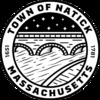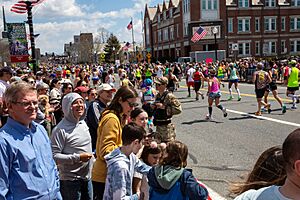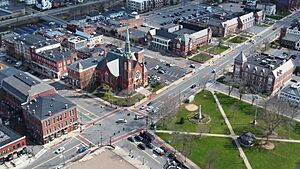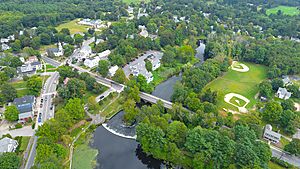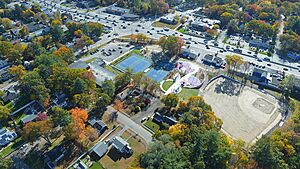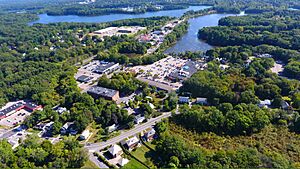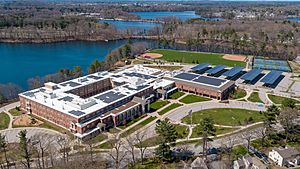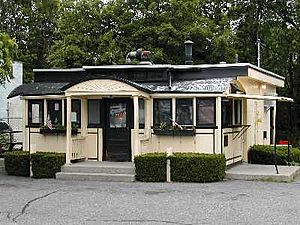Natick, Massachusetts facts for kids
Quick facts for kids
Natick, Massachusetts
|
|||
|---|---|---|---|
| Town of Natick | |||
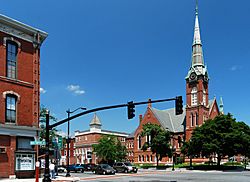
Natick town center
|
|||
|
|||
| Nickname(s):
Home of Champions
|
|||

Location in Middlesex County in Massachusetts
|
|||
| Country | United States | ||
| State | Massachusetts | ||
| County | Middlesex | ||
| Settled | 1651 | ||
| Incorporated | 1781 | ||
| Government | |||
| • Type | Representative town meeting | ||
| Area | |||
| • Total | 16.1 sq mi (41.6 km2) | ||
| • Land | 15.1 sq mi (39.1 km2) | ||
| • Water | 1.0 sq mi (2.5 km2) | ||
| Elevation | 181 ft (55 m) | ||
| Population
(2020)
|
|||
| • Total | 37,006 | ||
| • Density | 2,450.7/sq mi (946.4/km2) | ||
| Time zone | UTC−5 (Eastern) | ||
| • Summer (DST) | UTC−4 (Eastern) | ||
| ZIP Code |
01760
|
||
| Area code(s) | 508/774 | ||
| FIPS code | 25-43895 | ||
| GNIS feature ID | 0619407 | ||
| Website | www.natickma.gov | ||
Natick (pronounced NAY-tik) is a town located in Middlesex County, Massachusetts, United States. It's found near the center of the MetroWest area of Massachusetts. In 2020, about 37,006 people lived there. Natick is about 10 miles (16 km) west of Boston and is part of the larger Greater Boston area. For many years, Natick has been known as the "center of population" for Massachusetts.
Contents
- What's in a Name? The Meaning of Natick
- A Look Back: Natick's History
- Where is Natick? Geography and Weather
- Exploring Natick's Communities and Neighborhoods
- Who Lives in Natick? Population Facts
- Natick's Economy: Local Businesses
- Learning in Natick: Schools and Education
- Getting Around: Transportation in Natick
- Famous Faces: Notable People from Natick
- Places to See: Points of Interest in Natick
- Images for kids
- See also
What's in a Name? The Meaning of Natick
The name Natick comes from the language of the Massachusett Native American tribe. Many people think it means "Place of Hills." However, a more accurate meaning might be "place of [our] searching." This refers to John Eliot's search for a good spot to build his settlement for Native Americans.
A Look Back: Natick's History
Natick was first settled in 1651 by John Eliot, a missionary from England. He received money and permission to create a settlement for the Massachusett Indians, known as "Praying Indians." This settlement was on both sides of the Charles River. Natick was the first of Eliot's "praying towns" and became a very important center for them.
These towns were mostly run by Native American leaders like Waban. However, the Praying Indians were also expected to follow some Puritan customs. In reality, Natick blended both Native American and Puritan ways of life. Eliot and Native American translators even printed America's first Bible in the Algonquian language. Later, an Indigenous pastor named Rev. Daniel Takawambait led the church in Natick for many years.
The colonial government placed these settlements in a circle around Boston to help protect the area. Natick was the first and most well-known of these settlements. The land for Natick was given by the General Court as part of the Dedham Grant.
After some time, people started to focus more on converting Native Americans to Christianity. A school was set up, and a government was formed. However, during King Philip's War in November 1675, the Natick Indians were forced to go to Deer Island. Many died from sickness and cold. Those who survived found their homes destroyed when they returned. The Native American village never fully recovered. Over time, the land owned by the Native American community was sold to white settlers to pay off debts. By 1785, most of the Natick Indians had moved away.
In 1775, both European and Native American residents of Natick fought in the battles of Lexington, Concord, and Bunker Hill. They also served in the Continental Army. The names of Natick's Praying Indian soldiers are remembered on a stone marker. This marker is on Pond Street, near downtown Natick, along with the names of all of Natick's Revolutionary War veterans.
Natick officially became a town in 1781. Henry Wilson, who later became the 18th Vice President of the United States (1873–1875), lived most of his life in Natick. He worked as a shoemaker and schoolteacher and was known as the "Natick Cobbler." He is buried in Natick, and one of the town's middle schools is named after him.
Even though Natick was mainly a farming town, the invention of the sewing machine in 1858 led to many shoe factories opening. This business grew quickly and was at its peak by 1880. At that time, Natick had 23 factories and was the third-largest producer of shoes in the country. The shoes made in Natick were mostly heavy work shoes. Natick was famous for its brogan, a strong, ankle-high boot worn by soldiers in the American Civil War.
The special core for a more bouncy baseball was created by John W. Walcott. It was combined with the unique stitching pattern designed by Colonel William A. Cutler. These baseballs were made by H. Harwood & Sons, which was the world's first factory to make baseballs.
In 1874, a big fire in downtown Natick destroyed 18 business buildings, two shoe factories, the Town Hall, the fire station, and a church. Many homes were also lost. Even though no one died, the damage was huge for the town. In 1875, Natick's new Central Fire Station was finished. Today, this building is home to The Center for Arts in Natick (TCAN), a place for performing arts.
In 1891, Natick's fire department team won "The World's Hook and Ladder Championship." This was a competition between fire departments from four nearby towns. This victory gave Natick its nickname: "Home of Champions."
Every year on Patriots' Day, miles 8 through 12 of the Boston Marathon run through Natick along Route 135/Central St.. Thousands of people gather along the road to watch the race.
In December 2024, the town's Select Board approved a new policy about immigration. This policy stops town employees from asking about a person's citizenship or immigration status. It also prevents town employees from acting as immigration officers. However, there are exceptions for actions that follow official court orders or warrants related to immigration enforcement.
Where is Natick? Geography and Weather
Natick covers about 16.0 square miles (41.6 km²). About 15.1 square miles (39.1 km²) is land, and 1.0 square mile (2.5 km²) is water. About 7% of the town's area is water, including Lake Cochituate and Dug Pond.
Natick shares its borders with several other towns: Wellesley, Wayland, Weston, Framingham, Sherborn, and Dover.
| Climate data for Natick, Massachusetts (1981−2010 normals) | |||||||||||||
|---|---|---|---|---|---|---|---|---|---|---|---|---|---|
| Month | Jan | Feb | Mar | Apr | May | Jun | Jul | Aug | Sep | Oct | Nov | Dec | Year |
| Mean daily maximum °F (°C) | 33.7 (0.9) |
37.1 (2.8) |
46.2 (7.9) |
58.9 (14.9) |
68.8 (20.4) |
75.5 (24.2) |
81.5 (27.5) |
80.6 (27.0) |
73.7 (23.2) |
59.8 (15.4) |
51.6 (10.9) |
39.6 (4.2) |
58.9 (14.9) |
| Mean daily minimum °F (°C) | 16.4 (−8.7) |
18.0 (−7.8) |
25.5 (−3.6) |
35.6 (2.0) |
45.0 (7.2) |
56.3 (13.5) |
62.1 (16.7) |
60.2 (15.7) |
51.7 (10.9) |
39.5 (4.2) |
31.8 (−0.1) |
21.9 (−5.6) |
38.7 (3.7) |
| Average precipitation inches (mm) | 3.41 (87) |
3.17 (81) |
4.03 (102) |
4.14 (105) |
3.91 (99) |
4.02 (102) |
3.80 (97) |
3.72 (94) |
3.83 (97) |
4.39 (112) |
4.28 (109) |
4.05 (103) |
46.77 (1,188) |
| Average snowfall inches (cm) | 15.8 (40) |
10.8 (27) |
7.8 (20) |
2.2 (5.6) |
0 (0) |
0 (0) |
0 (0) |
0 (0) |
0 (0) |
0 (0) |
1.6 (4.1) |
10.0 (25) |
48.2 (122) |
| Average precipitation days (≥ 0.01 in) | 10.3 | 9.2 | 10.3 | 11.1 | 12.4 | 11.3 | 9.8 | 9.7 | 9.0 | 10.2 | 11.0 | 10.7 | 125 |
| Average snowy days (≥ 0.1 in) | 5.4 | 3.8 | 2.6 | 0.4 | 0 | 0 | 0 | 0 | 0 | 0 | 0.7 | 3.4 | 16.3 |
| Source: NOAA | |||||||||||||
Exploring Natick's Communities and Neighborhoods
Natick Center: The Heart of Town
Natick Center, also called Downtown Natick, is where Central Street and Main Street meet. It's the main civic and cultural area of the town.
Many public services are located downtown. You'll find the Natick Town Hall, Fire Department, Police Department, and the Morse Institute Library there. The Natick Town Common is also downtown, where many town events and community activities happen. In the 1990s, new buildings for the town hall, fire/police station, and an expanded library gave the downtown a fresh look. These new buildings stand alongside historic ones, churches, and many local businesses.
In 2012, Natick Center was named one of Massachusetts's cultural districts. This helps attract artists and businesses, boosts tourism, and helps preserve old buildings. The main spots in the Natick Center Cultural District are The Center for Arts in Natick, the Morse Institute Library, and the Natick Common.
South Natick: A Scenic Spot
South Natick is known for its beautiful natural areas. This is where the Native American settlers first arrived and started the town along the Charles River. Many residents of South Natick feel they have a unique identity from the rest of Natick. It's the only part of Natick that can be officially addressed separately by the US Post Office.
East Natick: Home to Businesses and Schools
East Natick is a community located along Oak Street and where Oak Street meets Worcester Street. Important places here include Jennings Pond and the Lilja School. The Longfellow Health Club, with its gym, pool, and tennis courts, is also in East Natick. The section of Route 9 in East Natick has many different stores and businesses.
West Natick: A Bustling Commercial Hub
West Natick is a large part of Natick that borders the town of Framingham. The Natick Mall and the Sherwood Plaza strip mall are the main shopping areas in West Natick. After World War II, many housing developments were built here, bringing more people to this part of town.
There are many businesses in West Natick along West Central Street. There's also another MBTA Commuter Rail train station here, in addition to the one downtown. The area along Route 135 in West Natick is the most crowded part of town, with many apartments and condos near the train station.
Natick's Unique Neighborhoods
Natick has several distinct neighborhoods, many of which were built in the late 1940s and 1950s.
Sherwood
Sherwood is one of the first neighborhoods built in West Natick after World War II. The homes are in a colonial style, and the street names are inspired by the Robin Hood stories. This area is popular because there's no through traffic, and many houses have been expanded.
Walnut Hill
Walnut Hill is a neighborhood north of downtown. It's known for the private boarding school Walnut Hill School for the Arts. Many Victorian-era houses line the streets here.
Wethersfield
The Wethersfield area is a residential neighborhood north of Route 9. It features many ranch-style houses built in the 1950s. This area is still popular with first-time home buyers because the houses are often more affordable.
Oak Street
South of Route 9, this section started as a summer vacation area with small cottages around Jennings Pond. Over the years, some houses grew bigger, but the area remains charming and quiet. North of Route 9, other small homes were built in the 1950s. There are also two industrial parks along North Oak Street with office buildings and warehouses.
Little South
Just south of the Natick Common, you'll find Little South. It's named this way because it's close to South Natick. Homes along Cottage Street were mostly built in the early 1950s and are well-kept. Important landmarks include a World War II monument and The Tobin School, a private school. Everett Street has larger farm homes, and Eliot Street has some of Natick's oldest houses.
Who Lives in Natick? Population Facts
| Historical population | ||
|---|---|---|
| Year | Pop. | ±% |
| 1850 | 2,744 | — |
| 1860 | 5,515 | +101.0% |
| 1870 | 6,404 | +16.1% |
| 1880 | 8,112 | +26.7% |
| 1890 | 9,118 | +12.4% |
| 1900 | 9,488 | +4.1% |
| 1910 | 9,866 | +4.0% |
| 1920 | 10,907 | +10.6% |
| 1930 | 13,589 | +24.6% |
| 1940 | 13,851 | +1.9% |
| 1950 | 19,838 | +43.2% |
| 1960 | 17,993 | −9.3% |
| 1970 | 31,057 | +72.6% |
| 1980 | 29,461 | −5.1% |
| 1990 | 30,510 | +3.6% |
| 2000 | 31,868 | +4.5% |
| 2010 | 32,786 | +2.9% |
| 2020 | 37,006 | +12.9% |
| 2022* | 36,272 | −2.0% |
| * = population estimate. | ||
In 2010, there were 32,786 people living in Natick. There were 13,080 households and 8,528 families. The population density was about 2,133 people per square mile (824 per km²).
About 85.4% of the people were White, 2% were African American, and 7.2% were Asian. About 3% of the population identified as Hispanic or Latino.
About 30.3% of households had children under 18 living with them. The average household had 2.42 people, and the average family had 3.02 people.
The median age in Natick was 38 years old. About 23% of the population was under 18, and 14.3% were 65 or older.
In 2007, the average income for a household in Natick was about $61,855. For families, it was about $85,056. Natick is surrounded by some of the wealthiest towns in Massachusetts, including Wayland, Weston, Wellesley, Dover, and Sherborn.
Natick's Economy: Local Businesses
Several important companies have their main offices in Natick. These include Cognex Corporation, MathWorks, and Exponent.
Learning in Natick: Schools and Education
Public Schools in Natick
The Natick Public School District runs several schools:
- High School:
- Natick High School: The current high school building opened in 2012. It cost $80 million to build. The school's mascot name was changed in 2012 to the "Redhawks."
- Middle Schools:
- Kennedy Middle School (a new building started construction in 2019)
- Wilson Middle School
- Elementary Schools:
- Brown Elementary School
- Lilja Elementary School
- Memorial Elementary School
- Bennett-Hemenway (Ben-Hem) Elementary School
- Johnson Elementary School (closed in 2024)
Private Schools in Natick
- Walnut Hill School for the Arts
- The Riverbend School (formerly Eliot Montessori School)
- The Tobin School
- Brandon School and Residential Treatment Center
- Saint Benedict Classical Academy (formerly Saint Benedict Elementary), located in the Harriet Beecher Stowe House
Getting Around: Transportation in Natick
The Natick Center station, located downtown, is served by the MBTA Commuter Rail Framingham/Worcester Line. This train line connects Natick to other towns and cities.
Bus service in Natick is provided by the MetroWest Regional Transit Authority.
Famous Faces: Notable People from Natick
Many interesting people have lived in or are connected to Natick:
- Horatio Alger Jr.: An author famous for his "rags to riches" children's books.
- John Carlson: An NHL player for the Washington Capitals.
- William Finn: A Tony Award-winning composer and lyricist for musicals like Falsettos.
- Doug Flutie: A well-known NFL and CFL football player who attended high school in Natick. He won the Heisman Trophy.
- Alison Fraser: A Broadway performer and two-time Tony Award nominee who grew up in Natick.
- Alan Gordon: A songwriter who wrote the hit song "Happy Together" for the Turtles.
- Tommy Heinsohn: A former basketball player for the Boston Celtics and a member of the Naismith Memorial Basketball Hall of Fame.
- Harold Kushner: A rabbi and author known for his book When Bad Things Happen to Good People.
- Meg Mallon: A professional golfer on the LPGA Tour.
- John O'Hurley: An actor best known for playing J. Peterman on the TV show Seinfeld.
- Jonathan Richman: A famous musician and founder of The Modern Lovers.
- Jim Riley: The drummer and band leader for the country band Rascal Flatts.
- Phil Schiller: A senior vice president of worldwide marketing at Apple Inc.
- Harriet Beecher Stowe: A famous author and abolitionist who wrote Uncle Tom's Cabin. She wrote her novel Old Town Folks while living in Natick.
- Henry Wilson: The 18th Vice President of the United States.
Places to See: Points of Interest in Natick
- The U.S. Army Soldier Systems Center (SSC): Also known as The Natick Army Labs, this facility creates military items like food rations, protective gear, and special uniforms.
- Natick Mall: This is the largest shopping center in New England.
- Cognex Corporation: The main office for this company is in Natick.
- MathWorks: The main office for this company, which is split into two campuses.
- The Walnut Hill School: A private school focusing on the arts. It sends more students to the Juilliard School than any other secondary school in the world.
- The Center for Arts in Natick (TCAN): Located in Natick's old Central Fire Station, this is a place to see live music, theater, and films.
- Casey's Diner: Built in 1922, this is one of the oldest operating diners in the United States. It's famous for its steamed hot dogs.
- Henry Wilson Shoe Shop: This historic building at 181 West Central Street is listed on the National Register of Historic Places.
- The Chabad Center of Natick: A synagogue and Jewish educational center in West Natick.
- The Morse Institute Library: A public library in Downtown Natick that offers many educational resources and programs.
- The Natick Historical Society: Located in the Bacon Free Library, it has exhibits about John Eliot, the Praying Indians, and Natick's history.
- The Boden Lane Cemetery: A small burial site established in 1815, with some gravestones dating back to the Revolutionary War.
Images for kids
See also
 In Spanish: Natick (Massachusetts) para niños
In Spanish: Natick (Massachusetts) para niños



